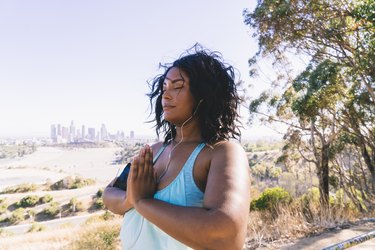Together with Athleta, we're compiling actionable wellness advice you need from the experts—and Well+Good is bringing it to life all year long at events in NYC. Here, MNDFL co-founder Ellie Burrows Gluck divulges her four-step plan to getting into meditation.
Video of the Day
Video of the Day
Meditation has got to be one of the greatest wellness traditions—sitting on comfy pillows, clearing your mind, becoming more self aware—what could be better? But, the most nerve-wracking part of meditating for newbies is figuring out how to really get into the zone (without feeling like you're phoning it in).
"It's tough for everyone when they begin a practice," says Ellie Burrows Gluck, co-founder and CEO of MNDFL—a group meditation space featuring expert teachers who provide a variety of meditating traditions and techniques. "Meditation won't turn off your mind and that's totally normal." See? Even a meditation professional feels the struggle.
Gluck compares meditating to going to the gym or learning an instrument. "You can't lose 10 pounds or play Mozart after a single session," Gluck says. "In the beginning, I felt a little bit like an infant learning how to walk. To this day, I've never had a thoughtless meditation in my life."
Rest assured that you're clearly not the only one having a hard time getting into a meditating mindset. For beginners, Gluck says to remember the four Cs: commitment, consistency, cumulative, and choice. Keep reading to get the intel on how to start.
1: Commitment
Just like with your workout routine, a meditation regimen takes the same amount of time and dedication—just minus all the sweat.
"If you want to build a practice you have to commit to doing so," Gluck says. "Most studies show you need about 10 minutes per day for about eight to 10 weeks to see the benefits." So even if that means starting out your morning doing a few breathing and self-reflection exercises when you wake up instead of your usual Instagram scroll, you'll slowly start noticing the results.
2: Consistency
As Gluck mentioned, it takes sticking to your 10-minute practice, but that doesn't mean it has to be done in the morning. A way to keep yourself accountable is mapping out your week and pencilling in those 10 minutes anywhere you can.
Just keep in mind that consistency isn't only about frequency. "It can be helpful to keep the time of day consistent, the length of your practice consistent, and even the environment consistent—think your favorite spot on a couch or designated corner with a meditation cushion," Gluck adds.
3: Cumulative
The third C is all about building upon your skills as they develop and not letting your progression stop. "The benefits build over time so if you want to see the benefits you have to practice regularly," Gluck says.
If you notice that your mind is wandering, Gluck suggests to lovingly (and without judgment) bring attention back to your breath. Just because your brain is getting a little too stimulated doesn't mean your whole practice is a wash, it's just about taking that moment to intentionally refocus.
4: Choice
Practicing meditation is empowering, because spending those 10 minutes for yourself shows that you're able to make the choice to take control of how you let the things and events in your life affect you.
"Much like we can become consumed by thoughts and then choose to come back to the breath on the cushion, off the cushion we can use that same awareness when we become consumed by emotions and then choose to sit in our discomfort instead of reacting in a way that might cause harm to us or someone else," Gluck explains.
And that has ripple effects. "Meditation is helpful because it can give us the tools to begin to become aware of how we are occurring in whatever moment we are in," Gluck says. "And that's reason enough to head right for the cushion!"
Is this an emergency? If you are experiencing serious medical symptoms, please see the National Library of Medicine’s list of signs you need emergency medical attention or call 911.

